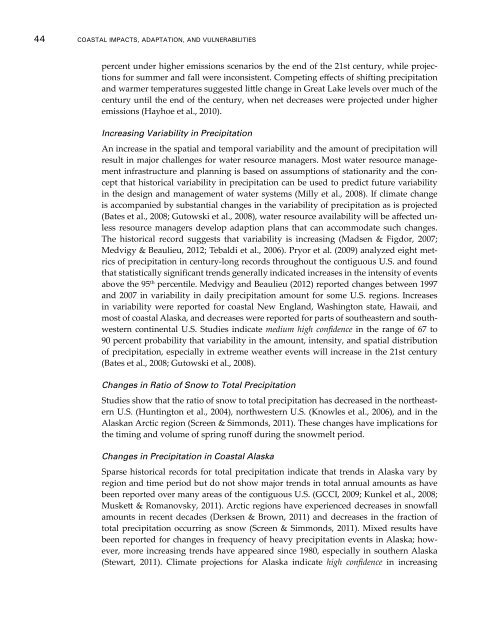Coastal Impacts, Adaptation, and Vulnerabilities - Climate ...
Coastal Impacts, Adaptation, and Vulnerabilities - Climate ...
Coastal Impacts, Adaptation, and Vulnerabilities - Climate ...
Create successful ePaper yourself
Turn your PDF publications into a flip-book with our unique Google optimized e-Paper software.
44 <strong>Coastal</strong> <strong>Impacts</strong>, <strong>Adaptation</strong>, <strong>and</strong> <strong>Vulnerabilities</strong>percent under higher emissions scenarios by the end of the 21st century, while projectionsfor summer <strong>and</strong> fall were inconsistent. Competing effects of shifting precipitation<strong>and</strong> warmer temperatures suggested little change in Great Lake levels over much of thecentury until the end of the century, when net decreases were projected under higheremissions (Hayhoe et al., 2010).Increasing Variability in PrecipitationAn increase in the spatial <strong>and</strong> temporal variability <strong>and</strong> the amount of precipitation willresult in major challenges for water resource managers. Most water resource managementinfrastructure <strong>and</strong> planning is based on assumptions of stationarity <strong>and</strong> the conceptthat historical variability in precipitation can be used to predict future variabilityin the design <strong>and</strong> management of water systems (Milly et al., 2008). If climate changeis accompanied by substantial changes in the variability of precipitation as is projected(Bates et al., 2008; Gutowski et al., 2008), water resource availability will be affected unlessresource managers develop adaption plans that can accommodate such changes.The historical record suggests that variability is increasing (Madsen & Figdor, 2007;Medvigy & Beaulieu, 2012; Tebaldi et al., 2006). Pryor et al. (2009) analyzed eight metricsof precipitation in century-long records throughout the contiguous U.S. <strong>and</strong> foundthat statistically significant trends generally indicated increases in the intensity of eventsabove the 95 th percentile. Medvigy <strong>and</strong> Beaulieu (2012) reported changes between 1997<strong>and</strong> 2007 in variability in daily precipitation amount for some U.S. regions. Increasesin variability were reported for coastal New Engl<strong>and</strong>, Washington state, Hawaii, <strong>and</strong>most of coastal Alaska, <strong>and</strong> decreases were reported for parts of southeastern <strong>and</strong> southwesterncontinental U.S. Studies indicate medium high confidence in the range of 67 to90 percent probability that variability in the amount, intensity, <strong>and</strong> spatial distributionof precipitation, especially in extreme weather events will increase in the 21st century(Bates et al., 2008; Gutowski et al., 2008).Changes in Ratio of Snow to Total PrecipitationStudies show that the ratio of snow to total precipitation has decreased in the northeasternU.S. (Huntington et al., 2004), northwestern U.S. (Knowles et al., 2006), <strong>and</strong> in theAlaskan Arctic region (Screen & Simmonds, 2011). These changes have implications forthe timing <strong>and</strong> volume of spring runoff during the snowmelt period.Changes in Precipitation in <strong>Coastal</strong> AlaskaSparse historical records for total precipitation indicate that trends in Alaska vary byregion <strong>and</strong> time period but do not show major trends in total annual amounts as havebeen reported over many areas of the contiguous U.S. (GCCI, 2009; Kunkel et al., 2008;Muskett & Romanovsky, 2011). Arctic regions have experienced decreases in snowfallamounts in recent decades (Derksen & Brown, 2011) <strong>and</strong> decreases in the fraction oftotal precipitation occurring as snow (Screen & Simmonds, 2011). Mixed results havebeen reported for changes in frequency of heavy precipitation events in Alaska; however,more increasing trends have appeared since 1980, especially in southern Alaska(Stewart, 2011). <strong>Climate</strong> projections for Alaska indicate high confidence in increasing
















